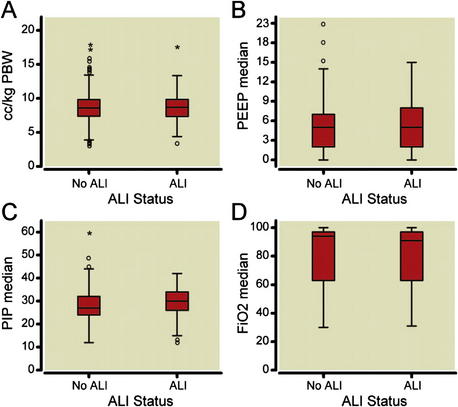Critical Care Medicine
Adult Critical Care
A Description of Intraoperative Ventilator Management in Patients with Acute Lung Injury and the Use of Lung Protective Ventilation Strategies
Blum JM, Maile M, Park PK, et al (Univ of Michigan Health System, Ann Arbor) Anesthesiology 115:75-82, 2011§
Evidence Ranking
• C
Expert Rating
• 2
Abstract
Conclusion
Similar ventilation strategies are used between patients with ALI and those without ALI. These findings suggest that anesthesiologists are not using lung protective ventilation strategies when ventilating patients with low Paco2/Fio2 ratios and ALI, and instead are treating hypoxia and ALI with higher concentrations of oxygen and peak pressures (Figs 2, Tables 4 and 5).

Full access? Get Clinical Tree



 represent outliers (1.5–3 X box length), * represent extreme outliers (more than 3 X box length). (B) Median positive end-expiratory pressure (PEEP) by ALI status. Solid lines represent median values, boxes represent the interquartile range, T bars represent 95% of total sample,
represent outliers (1.5–3 X box length), * represent extreme outliers (more than 3 X box length). (B) Median positive end-expiratory pressure (PEEP) by ALI status. Solid lines represent median values, boxes represent the interquartile range, T bars represent 95% of total sample,  represent outliers (1.5–3 X box length), * represent extreme outliers (more than 3 X box length). (C) Median PIP by ALI status. Solid lines represent median values, boxes represent the interquartile range, T bars represent 95% of total sample,
represent outliers (1.5–3 X box length), * represent extreme outliers (more than 3 X box length). (C) Median PIP by ALI status. Solid lines represent median values, boxes represent the interquartile range, T bars represent 95% of total sample,  represent outliers (1.5–3 X box length), * represent extreme outliers (more than three times box length). (D) Median F
represent outliers (1.5–3 X box length), * represent extreme outliers (more than three times box length). (D) Median F represent outliers (1.5–3 X box length), * represents extreme outliers (more than 3 X box length). ALI = acute lung injury; F
represent outliers (1.5–3 X box length), * represents extreme outliers (more than 3 X box length). ALI = acute lung injury; F
